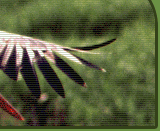Decreasing of open meadow area, overgrowing with trees and bushes Description: Large areas of natural meadows that formerly were regularly cut or grazed have been abandoned. Bushes and trees are invading these meadows and are decreasing the area of meadow habitats as well as the area available to bird species requiring such habitats. Large areas of former floodplain meadows have presently turned into shrub lands and even forests. This process is ongoing and its speed is dependent on various factors including water regime and meadow type. In order to stop this process, a restoration of mowing or grazing activities is one of the most urgent steps to be taken. Location: All territories chosen as project sites are affected by this threat. Impact on habitat and species: Bird species most affected by this threat are those requiring large open areas like Crex crex*, Gallinago media and Asio flammeus. Although these species do not totally avoid presence of scattered small bushes, they do not inhabit areas severely overgrown with bushes. In overgrowing meadows Crex crex* occur in significantly lower densities than in open meadows. Gallinago media is particularly sensitive to decrease of suitable habitat as this species has a lek-based mating system that is more energy demanding and involves more individuals than pair-based mating. Thus a meadow area which would be sufficient for 2 individuals (a pair) of the othe species cannot support a lek of Gallinago media. According to EU Species Action Plan for Aquila pomarina*, one of the main threats to this species is loss of important feeding habitats: grassland and wet meadows. Aquila pomarina* breeds in forest, but feeds on adjacent open landscape. Availability of the latter is very important factor in the choice of nest site (EU Species Action Plan for Lesser Spotted Eagle, 2001, BirdLife International). Although this species is not affected by early stages of overgrowing, it avoids using areas where trees and large bushes appear, especially areas with closed tree or bush foliages. In territories where areas of suitable feeding habitat decreases, the total area of the species home range increases to compensate the losses of feeding habitat availability. As a result, the breeding density of the species decreases. Overgrowing occurs in all types of meadows present in the sites. Due to growing conditions 6210* Semi-natural dry grasslands and scrubland facies on calcareous substrates (Festuco-Brometalia) (important orchid sites), 6270* Fennoscandian lowland species-rich dry to mesic grasslands and 6510 Lowland hay meadows (Alopecurus pratensis, Sanguisorba officinalis) are most vulnerable to overgrowing followed by 6410 Molinia meadows on calcareous, peaty or clayey-silt-laden soils (Molinion caeruleae) and 6530* Fennoscandian wooded meadows. Although overgrowing with bushes is not as fast in 6230* Species-rich Nardus grasslands, on silicious substrates in mountain areas (and submountain areas in Continental Europe) and in 6450 Northern boreal alluvial meadows, they are endangered as well as management of these meadows in most cases has ceased even more than 10 years ago. In addition, 6450 Northern boreal alluvial meadows have become more vulnerable to this threat due to changes in water regime. | 







